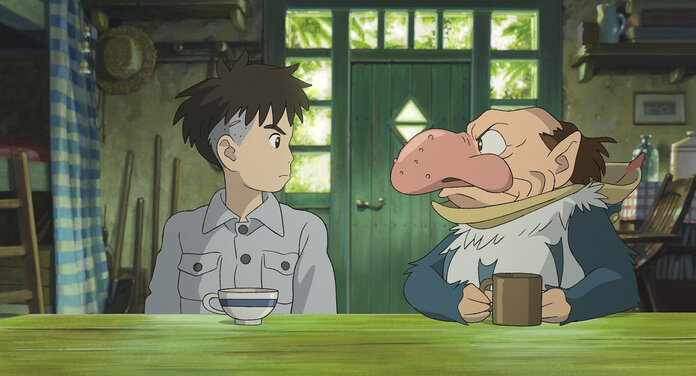
The Boy and the Heron
Studio: GKIDS
Hayao Miyazaki
Oct 02, 2023
Web Exclusive
![]()
Hayao Miyazaki’s (allegedly) final film, The Boy and the Heron, is a visually dazzling feature that suffers from too many narrative ideas stuffed into one product.
Set during World War II, The Boy and the Heron follows Mahito, a teenager coming to terms with his mother’s death. In an attempt to create a normal life for Mahito, his father moves them to the countryside to stay with Mahito’s new stepmother and get a break from the war-torn chaos of Tokyo. Instantly, Mahito struggles with moving on, fueled by his experiences with an unfamiliar environment, bullying at school and a well-intentioned, but still distant, stepmother.
Mahito’s difficulties only increase when he discovers a talking gray heron who won’t leave him alone, constantly beckoning him to visit an abandoned tower nearby. Mahito tries to avoid the bird for as long as possible, even fashioning a bow-and-arrow to chase the creature away. Eventually, he succumbs to the bird’s temptations and travels to the tower, where he finds himself sucked into a fantastical new world. From there, Mahito begins a vast journey of self-discovery as he meets new characters, discovers more about the flow of nature and figures out his role within the world.
From the opening sequence to the closing credits, it makes sense why Miyazaki would want The Boy and the Heron to be his final film. In essence, it captures everything that the filmmaker has built his career around. The film’s visuals are absolutely astonishing, featuring bright, dynamic colors that bring the alternate worlds and their eccentric characters to life. Its narrative structure is unwaveringly focused, following Mahito as he discovers a new reality that is like his world in some ways yet filled with alternate possibilities and distinct nuances. Like most of Miyazaki’s characters, Mahito must realize that no world is perfect. Regardless of how idyllic different realities may seem, they all carry their own problems and flaws. Through this lens, Miyazaki suggests that we always have the decision to recognize the world’s shortcomings and work to fix them. It’s just about making the right choice.
Even though The Boy and the Heron’s style and structure are reminiscent of Miyazaki’s best works, the film still feels somewhat hollow. The “character travels through a new world” narrative almost works against the film, as there’s no sense of fluidity between different set pieces. For the film’s entire runtime, Mahito moves from one sequence to the next, each representing a distinct philosophical idea that barely connects to the rest of the story. The result is a film that says a lot, but doesn’t have a definite idea of what any of it means. This problem is resolved in the film’s final act, which features a beautiful, emotional summation of love, loss and hope. But, the payoff happens too late, making much of the story feel thematically diluted.
Regardless, The Boy and the Heron is deeply entertaining, and it is always a joy to see Miyazaki’s work on-screen. This is clearly a passion project for the director, and in some senses, its inaccessibility makes it exciting. But, the looseness of its narrative doesn’t make it hard to buy into the film’s ideas. It makes it hard to find them. (gkids.com)
Author rating: 6.5/10
Average reader rating: 7/10
Current Issue

Issue #72
Apr 19, 2024 Issue #72 - The ‘90s Issue with The Cardigans and Thurston Moore
Most Recent
- 12 Best Songs of the Week: Charly Bliss, Jessica Pratt, The WAEVE, Hamish Hawk, and More (News) —
- John Carpenter on ‘Lost Themes IV: Noir’ (Interview) —
- Thomas Powers (of The Naked & Famous) Shares New Single, “Empty Voices” feat. Julien Baker (News) —
- illuminati hotties Shares Video for New Song “Can’t Be Still” and Announces New Tour Dates (News) —
- Jordan Lindley Shares New Single “Sometime Someday” (News) —

Comments
Submit your comment
There are no comments for this entry yet.